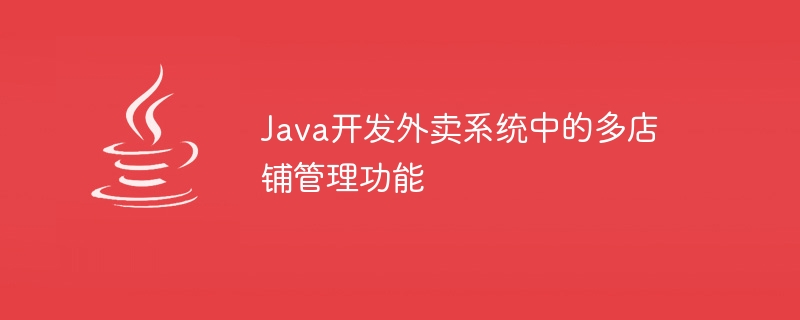
Java develops multi-store management functions in takeout systems
With the rapid development of the Internet and people’s pursuit of convenient life, takeout services have become an indispensable part of people’s lives. A missing part. In order to meet users' needs for diversified dishes and diversified brands, the takeout system needs to provide multi-store management functions. This article will introduce how to implement efficient multi-store management functions in a takeout system developed in Java.
1. Requirements Analysis of Store Management Module
In the takeout system, each store is an independent entity with its own menu, order, user evaluation and other information. Therefore, the multi-store management function mainly includes the following requirements:
- Store information management: including the management of basic information such as store name, address, and phone number, as well as operations such as store business hours, minimum delivery amount, and delivery range Parameter settings.
- Dish management: Each store has its own menu and needs to be able to easily add, delete and edit dishes, as well as set the price, description, pictures and other information of the dishes. It also needs to support the management of dish categories to facilitate user search and filtering.
- Order management: Orders received by each store need to be managed and processed. It is necessary to provide management functions for order lists, order details and order status, including operations such as order receiving, delivery and completion.
- User evaluation: User evaluation of each store has an important impact on other users' choices. Therefore, it is necessary to provide user evaluation management functions, including viewing evaluations, replying to evaluations, and statistical evaluations, etc.
2. Implementation plan of multi-store management function
In order to achieve efficient multi-store management function, the following implementation plan can be adopted:
- Database design: required Design an appropriate database structure to store data such as store information, dish information, order information, and evaluation information. You can use a relational database such as MySQL to store data, and use an ORM framework such as Hibernate or MyBatis to simplify data operations.
- Store management module: You can design a store management module to handle operations such as adding, deleting and editing store information. You can use Java Web frameworks such as Spring MVC to implement the management interface, and use RESTful interfaces to handle front-end and back-end data interaction.
- Dish management module: You can design a dish management module to handle the management of dish information. You can use the image upload component to upload and display dish images, and use technologies such as form verification and exception handling to ensure the legitimacy of the dish information.
- Order management module: You can design an order management module to be responsible for the management and processing of orders. Message queue technology such as RabbitMQ can be used to implement asynchronous processing of orders and improve the concurrency and response speed of the system.
- User evaluation module: You can design a user evaluation module to handle the management and statistics of user evaluations. Caching technology such as Redis can be used to store statistical information such as the number of user reviews and average scores to improve system performance and response speed.
3. Optimization and expansion of multi-store management functions
In order to further improve the performance and user experience of multi-store management functions, the following optimization and expansion can be carried out:
- Introduction of distributed architecture: Use distributed architecture such as microservice architecture to improve the scalability and reliability of the system. Functions such as store management, menu management, order management, and user evaluation can be split into different services, and dynamic discovery and load balancing of services can be achieved by using service registration and discovery frameworks such as Zookeeper or Eureka.
- Use caching: Use caching technology such as Redis to cache popular store information and dish data to improve the system's access speed and responsiveness. Cache refresh strategies and expiration strategies can be used to ensure the real-time and accuracy of data.
- Introducing search engines: Use search engine technology such as Elasticsearch to implement full-text search functions for stores and dishes, making it easier for users to search and filter. You can use search engine relevance algorithms and word segmentation technology to improve search accuracy and efficiency.
- Data statistics and analysis: Use data analysis tools such as Hadoop and Spark to analyze and mine user reviews and order data, and provide store managers with statistics and analysis on user preferences, order trends, dish recommendations, etc. Report.
Summary:
Multi-store management function is an important part of Java development of takeout system. Through reasonable demand analysis and technical solution design, efficient store information management, dish management, Functions such as order management and user evaluation management. With the rapid development of the Internet and the constant changes in user needs, the multi-store management function of the takeout system still has a lot of room for expansion and optimization. By introducing technical means such as distributed architecture, caching technology, search engines and data analysis, the performance, scalability, user experience and operational effects of the system can be improved.
The above is the detailed content of Java develops multi-store management functions in takeout system. For more information, please follow other related articles on the PHP Chinese website!






